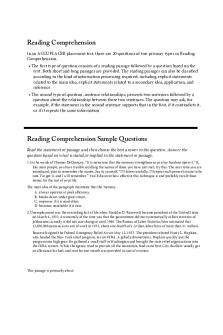QSO 322 Module Six Comprehension Questions PDF

| Title | QSO 322 Module Six Comprehension Questions |
|---|---|
| Author | Tanner Harrell |
| Course | Logistics Management |
| Institution | Southern New Hampshire University |
| Pages | 3 |
| File Size | 71.3 KB |
| File Type | |
| Total Downloads | 53 |
| Total Views | 135 |
Summary
Module Six Comprehension Questions. This has the questions and answers for this assignment, and I got a 100 on this assignment....
Description
Tanner Harrell QSO 322 Module Six Comprehension Questions 1.
Discuss the relationship between service level, uncertainty, safety stock, and order quantity. How can trade-offs between these elements be made? (Ch. 7) Service level can be defined as the amount of product that a company targets to sell for a
given period of time. This amount is specified by the management team and can be measured by performance cycle time, order fill rate, case fill rate, line fill rate, or a combination of any of these. Uncertainty is everywhere when it comes to supply, demand, and performance. Two major forms are demand uncertainty and performance cycle uncertainty. Safety stock is the number of products that a company keeps on-hand to help prevent the possibility of a stockout. Order quantity is simply how much is or needs to be ordered. The element of service level can be the one element that dictates many of the other elements. Depending on the service level that is set by management, the order quantity and safety stock can be calculated with different predictions of uncertainty. If they demand was higher than the supply, it can be replenished with the safety stock until they are both replenished by the order quantity.
2.
What is the difference between the probability of a stockout and the magnitude of a stockout? (Ch. 7)
The probability of a stockout has to do with the amount of inventory that is available to replenish products after a higher demand. The lower the amount of inventory, then the higher probability there is of a stockout. The magnitude of a stockout deals with the fill rate, which is “the percentage of units that can be filled when requested from available inventory” (Bowersox,
2019). Easily translated, the probability of a stockout is the likelihood that it will actually happen, and the magnitude of a stockout is how easily or difficult the company will handle a stockout if it were to occur.
3.
Customer-based inventory management strategies allow the use of different availability levels for specific customers. Discuss the rationale for such a strategy. Are such strategies discriminatory? Justify your position. (Ch. 7) Having a customer-based inventory management strategy can make a lot of sense as it
ensures that the customers that purchase or sell most of the product are first in line to have their stocks replenished. Although I do believe these strategies can be somewhat discriminatory, I do believe they are somewhat necessary. If these customer-based inventory management strategies are implemented, it could possibly maximize profits, but it could also cause other businesses to lose profits. Some customers might sell more than others, but the ones that do not sell as much could potentially run out of inventory and not be able to provide to their clientele.
References Bowersox, D. (2019, January 15). Supply Chain Logistics Management, 5th Edition. [[VitalSource Bookshelf version]]. Retrieved from vbk://9780077729134...
Similar Free PDFs

QSO 321 Module Eight Assignment
- 1 Pages

Module Six Case Analysis
- 3 Pages

Module Six Short Answer
- 1 Pages

QSO
- 61 Pages

501 READING COMPREHENSION QUESTIONS
- 169 Pages

SCS 100 Module Six Reflection
- 6 Pages

HCM 205 Module Six Worksheet
- 7 Pages

6-2 Module Six Short Responses
- 2 Pages
Popular Institutions
- Tinajero National High School - Annex
- Politeknik Caltex Riau
- Yokohama City University
- SGT University
- University of Al-Qadisiyah
- Divine Word College of Vigan
- Techniek College Rotterdam
- Universidade de Santiago
- Universiti Teknologi MARA Cawangan Johor Kampus Pasir Gudang
- Poltekkes Kemenkes Yogyakarta
- Baguio City National High School
- Colegio san marcos
- preparatoria uno
- Centro de Bachillerato Tecnológico Industrial y de Servicios No. 107
- Dalian Maritime University
- Quang Trung Secondary School
- Colegio Tecnológico en Informática
- Corporación Regional de Educación Superior
- Grupo CEDVA
- Dar Al Uloom University
- Centro de Estudios Preuniversitarios de la Universidad Nacional de Ingeniería
- 上智大学
- Aakash International School, Nuna Majara
- San Felipe Neri Catholic School
- Kang Chiao International School - New Taipei City
- Misamis Occidental National High School
- Institución Educativa Escuela Normal Juan Ladrilleros
- Kolehiyo ng Pantukan
- Batanes State College
- Instituto Continental
- Sekolah Menengah Kejuruan Kesehatan Kaltara (Tarakan)
- Colegio de La Inmaculada Concepcion - Cebu







